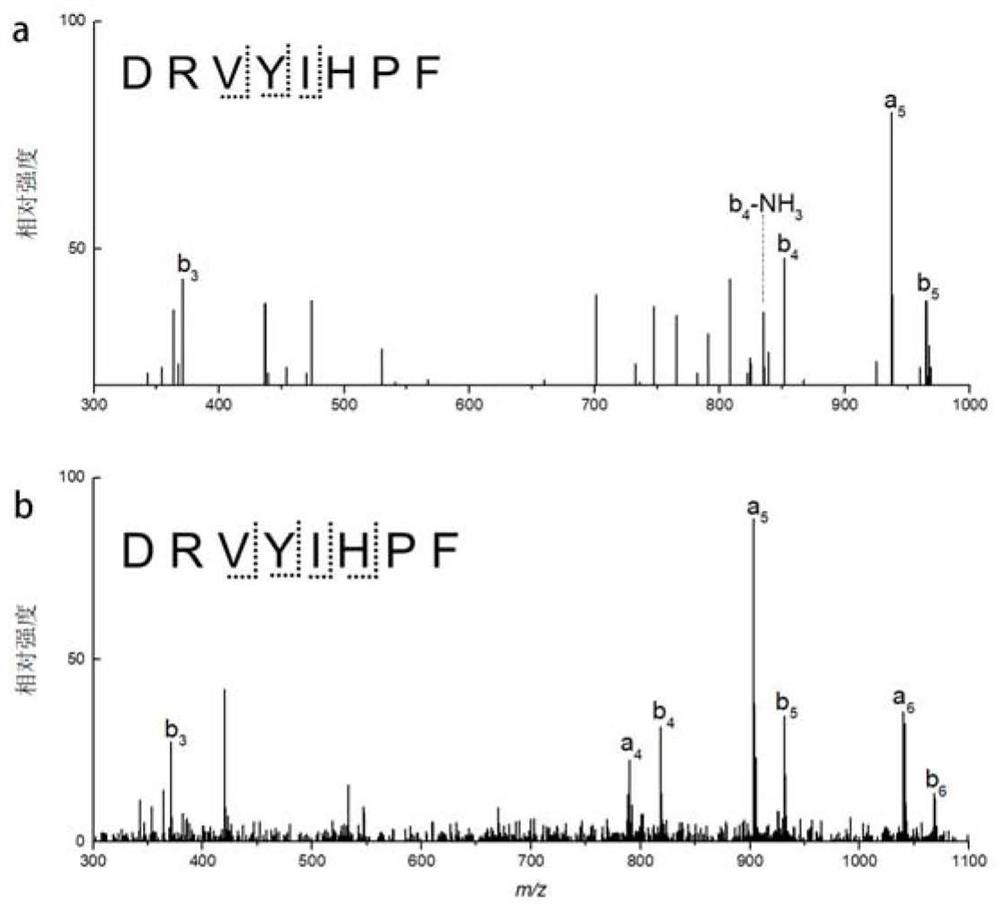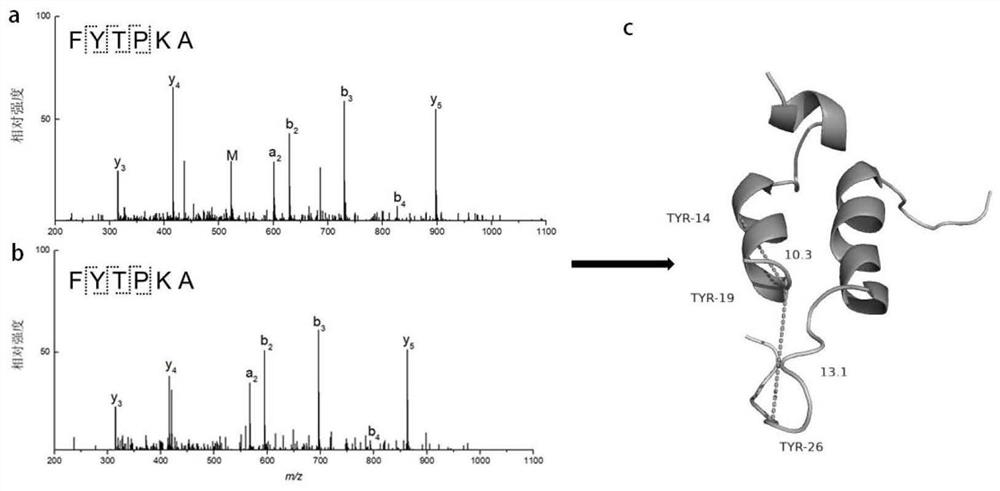Method for constructing three-dimensional protein structure based on specific cross-linked tyrosine
A three-dimensional structure, protein technology, applied in the field of cross-linking mass spectrometry, can solve the problems of difficult functionalization, no reports of tyrosine residue cross-linking technology, etc.
- Summary
- Abstract
- Description
- Claims
- Application Information
AI Technical Summary
Problems solved by technology
Method used
Image
Examples
Embodiment 1
[0024] This embodiment discloses a method for preparing a specific cross-linking tyrosine cross-linking agent, which includes three steps:
[0025]
[0026] Step 1: Synthesis of 1,2,2-dicarboxyethylphenylhydrazine (EPHD, 1)
[0027] 0.5 g of diphenyl carbonate (1 eq., 2.3 mM) was melted at 80° C. in a 100 mL flask, and then 0.5 g of urethane (2 eq., 4.6 mM) was added to react for 1 h. Purification by silica gel column chromatography (EtOAc / petroleum ether solution 1:3) gave 1 as a white solid. 1 H NMR(400MHz,DMSO)δ9.68(s,1H),9.25(s,1H),7.41(t,J=7.9Hz,2H),7.24(t,J=7.4Hz,1H),7.11(d , J=7.9Hz, 2H), 4.07 (dd, J=14.1, 7.1Hz, 2H), 1.19 (t, J=7.1Hz, 3H). 13 C NMR (101MHz, DMSO) δ156.90, 155.32, 151.07, 129.95, 125.86, 121.94, 61.17, 14.98.
[0028] Step 2: Synthesis of Compound 2
[0029] 0.226 g of ethylphenylhydrazine-1,2-dicarboxylate (compound 1, 1 eq.) was heated to 80°C under an inert atmosphere. A mixture of triethylamine (1 eq.) and cystamine dihydrochloride (0.5 eq.) w...
Embodiment 2
[0033] Crosslinker specifically targets tyrosine in angiotensin II
[0034] (1) Chemical cross-linking reaction: Angiotensin II was dissolved in 100 mM PB buffer at pH 7.40. 3 mL of 1 mM insulin was reacted with the cross-linking agent in a molar ratio of 1:2 at a voltage of 0.36 V for 4 hours at room temperature.
[0035] (2) The cross-linked angiotensin II was analyzed by Agilent 1290 Infinity liquid chromatography-BrukermicrOTOF-Q II mass spectrometer (LC-MS n ) for analysis. Liquid phase separation was performed using an Agilent Zorbax 300SB-C18 reversed-phase column (4.6×250 mm, 5 μm, column temperature 40° C.) prior to mass spectrometry analysis. The flow rate is 1mL / min; the linear gradient is: 0-5min for 5%B, 6-55min for 5-60%B, 56-60min for 60-98%B, mobile phase buffers A and B containing 0.1% B respectively Formic acid in water and acetonitrile. MS 2 Spectra were generated by collision-induced dissociation (CID) with an energy of 15 eV.
[0036] (4) The cross-l...
Embodiment 3
[0041] Three-dimensional structure identification of insulin
[0042] (1) Chemical cross-linking reaction: Insulin was dissolved in 100 mM PB buffer at pH 7.40. 3 mL of 0.2 mM insulin was reacted with the cross-linking agent in molar ratios of 1:2, 1:10 and 1:20 at a voltage of 0.36V for 4 hours at room temperature.
[0043] (2) Use pepsin dissolved in 1% acetic acid solution to carry out enzymatic hydrolysis reaction on the above solution, incubate at 37°C for 6.5 h, the mass ratio of pepsin to protein is 50:1, and the final concentration of insulin after enzymatic hydrolysis is 0.5 mg / mL.
[0044] (3) Using the Agilent 1290Infinity liquid chromatography-Bruker micrOTOF-QII mass spectrometer (LC-MS) n ) for analysis. Liquid phase separation was performed using an Agilent Zorbax 300SB-C18 reversed-phase column (4.6×250 mm, 5 μm, column temperature 40° C.) prior to mass spectrometry. The flow rate is 1mL / min; the linear gradient is: 0-5min for 5%B, 6-55min for 5-60%B, 56-6...
PUM
 Login to View More
Login to View More Abstract
Description
Claims
Application Information
 Login to View More
Login to View More - R&D
- Intellectual Property
- Life Sciences
- Materials
- Tech Scout
- Unparalleled Data Quality
- Higher Quality Content
- 60% Fewer Hallucinations
Browse by: Latest US Patents, China's latest patents, Technical Efficacy Thesaurus, Application Domain, Technology Topic, Popular Technical Reports.
© 2025 PatSnap. All rights reserved.Legal|Privacy policy|Modern Slavery Act Transparency Statement|Sitemap|About US| Contact US: help@patsnap.com



